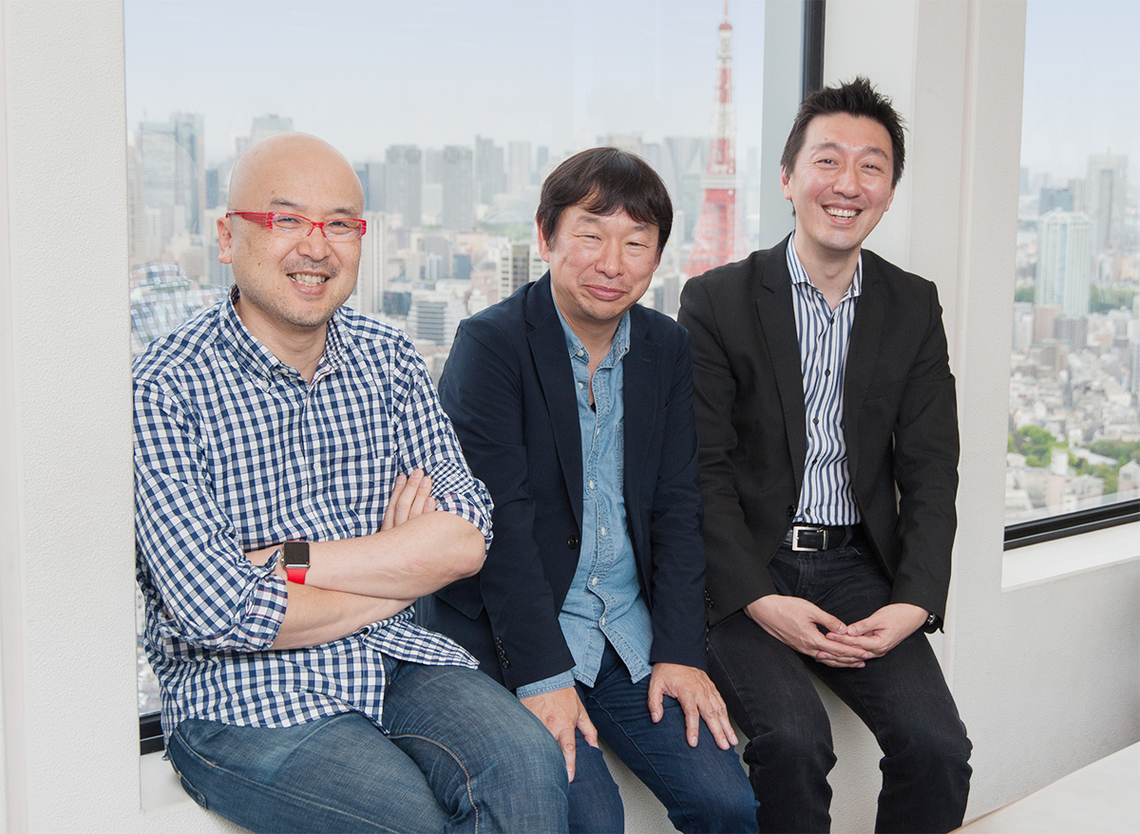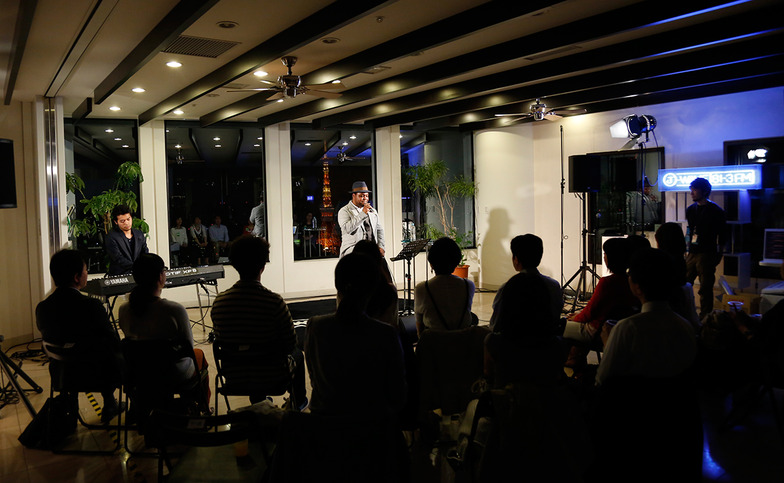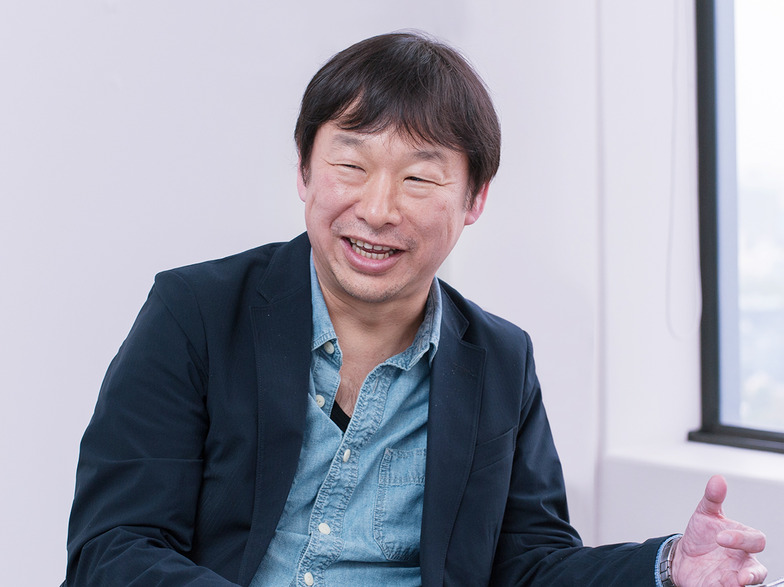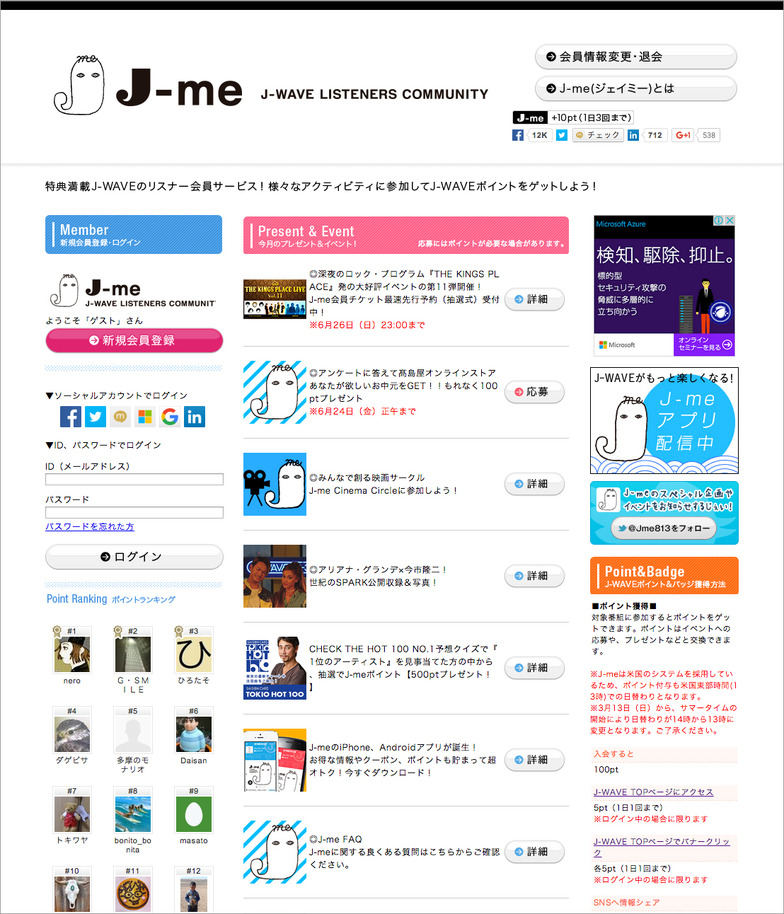Note: This website was automatically translated, so some terms or nuances may not be completely accurate.
In the Age of Information "Grains of Sand" How Radio Enables Fan Building

Naoyuki Sato
Fanbase Company, Inc.

Motohiko Tokuriki
Agile Media Network Co., Ltd.

Kenji Matsuo
J-WAVE
Now that information can be conveyed through various methods, radio's distinctive feature—the "deep relationship between the personality and the listener"—is beginning to attract renewed attention.
By viewing radio not just as a mass medium but as a platform capable of fostering "fan-based" communication, could we find hints for building new relationships between companies and consumers? Guided by this idea, Communication Director Sato Naoyuki, Tokuriki Motohiko, who promotes the potential of corporate social media use, and J-WAVE's Matsuo Kenji engaged in a discussion.
(Interviewer = Editorial Department)

Radio and Listeners: Unity Builds Trust
──In today's era of diverse media and information overload, it's often called a time when "messages don't get through." Amidst this, radio's power to consistently maintain a sense of closeness with listeners, both past and present, is drawing renewed attention. Mr. Sato, who has long discussed radio's potential, how do you view radio in the modern age?
Sato: Having worked in advertising for a long time, I feel radio has never had such high potential as it does now. This might be the biggest opportunity in the last 20 years or so. One key factor is the significant polarization of the media landscape. Simply put, it's about whether people use the internet or not. In this line of work, the internet feels like air we breathe, but a survey (Nielsen, 2014) actually shows that "only 52 million people use internet services, including search, at least once a month" – though this is PC-based. That means roughly 75 million people aren't using search, video sites, or e-commerce. Of course, many people use smartphones, but even then, the national average adoption rate is only around 50%. Even among users, many primarily use their phones for email, LINE, and games. Considering all this, I estimate there are probably 70 to 90 million people in Japan who don't routinely use the internet. Furthermore, survey data shows Tokyo overwhelmingly dominates both internet search usage and train ridership. Tokyo is practically a separate country. Cutting-edge marketers living in Tokyo can't grasp this disconnect because everyone around them uses the internet extensively. Meanwhile, for many people living in regional areas, private car use is common. They don't look at their smartphones while driving. Their daily exposure is to things like car radios. Adding to this situation is another factor: information simply doesn't reach people living mainly in Tokyo and some other major cities anymore, even when it's exposed normally.

──So it's that the sheer volume of information prevents it from reaching them?
Sato: Yes. The volume of circulating information keeps growing. By 2020, the annual flow of information is predicted to reach 40 zettabytes (10 to the 21st power). Since 1 zettabyte is said to be "equivalent to the number of grains of sand on all the world's beaches," it's practically infinite. It's unimaginable. In my book 'Planning for Tomorrow,' I called this the "Information 'Grain of Sand' Era." Within this, what gains trust are networks of friends, acquaintances, or "fans" who strongly support specific products or content. The intimacy of radio—centered around live broadcasts where personalities speak directly into your ear—feels very close to the words conveyed by friends or fans. Radio has been this kind of medium since before the internet, but as the surrounding environment changed, this characteristic became more pronounced.
──From the perspective of fans, you, Mr. Tokuriki, have been advocating and continuing activities where fans of companies or products themselves promote the next wave of fan creation through what you call "ambassador programs."
Tokuriki: We support companies in leveraging their fans' power for marketing. Now, sharing on SNS has become routine, and users themselves are becoming media. I believe this "user-as-media" phenomenon is the revolution of the digital age. Companies should rely more on these fans who are becoming media themselves. Amid recent environmental changes, there's much discussion about how corporate marketing must change too, but I think many misunderstand the direction of these changes. Even with the so-called "decline in reading books," the actual amount of text people are consuming has increased, right? In radio terms, media diversification might mean the culture of "listening solely to audio content" has relatively declined. Yet, people often leave TV shows on in the background, multitasking while just listening to the audio for a sense of satisfaction. With video streaming, complaints about audio cutting out far exceed those about video interruptions. Audio information feels fundamentally rooted, closer to natural human conversation. Furthermore, as Satonao pointed out, whether information truly resonates depends heavily on credibility. This aligns perfectly with radio's characteristic of maintaining a very close distance with its fans. Whether radio stations define the value they provide as broadcast wave delivery, "audio content" provision, or information for fan communities will depend on their strategy. But with listening mechanisms like "radiko.jp," which streams programs online, acting as a tailwind, I truly believe the possibilities have expanded significantly.
Building a Fan Base from Scratch
──The membership organization "J-me" that Matsuo-san oversees at J-WAVE is precisely such a fan community. Could you share J-WAVE's philosophy and the initiatives undertaken through this organization?
Matsuo: Amidst the dramatic shift in communication brought by digital, we felt a sense of urgency that we too must change. Specifically, we needed to get closer to our listeners. As Tokuriki-san pointed out, we've entered an era where users possess the power to communicate on par with traditional mass media. We believed the relationship between radio and its listeners, if left unattended, would crumble. Previously, J-WAVE didn't operate with such a strong awareness of the real listeners. Rather than fostering deep communication, we mainly provided recommended content while maintaining a certain distance. We had an email membership organization of around 250,000 people, but it was primarily focused on one-way newsletter distribution.
──So J-me took over that organization?
Matsuo: An internal discussion arose questioning whether a relationship based solely on sending a weekly email newsletter to 250,000 people was futile. We wanted to build a fan base that would engage closely with us, different from before, and continuously express our hospitality. So, we decided to recruit participants from scratch. We're now at 110,000 members, and even that feels like a lot to us.
Sato: Recruiting from scratch is a huge decision! Not many companies would do that. The fact that you still feel 110,000 is too many shows Matsuo-san believes "it's not about numbers." Rather than having many isolated connections, the key to future marketing is whether we can create a network where 100 passionate individuals each influence another 100 people around them. What did J-me prioritize when it launched?
Matsuo: Our primary focus was recognizing that our greatest strength lies in our listeners. They live in Tokyo, use online searches daily, and know interesting niche topics. We realized we couldn't attract new listeners or convey our value to companies and ad agencies unless we could clearly position ourselves as a media platform with such listeners. We don't need that old-fashioned, distant approach anymore. Even though people said it wasn't our style, we created characters (laughs), and we even chose the name J-me through a public contest among our listeners. It embodies the meaning of connecting our station with "me" (the listener).
The Value of Radio Beyond "Mass"
Tokuriki: Hearing you talk just now, I realized radio might have value beyond being just "mass media." Take TV, for example. You flip through channels casually, engaging with programs individually, so the sense of loyalty to specific stations isn't that strong. On the other hand, for a medium like radio, where listeners must actively tune in, strategically, it probably makes more sense to project the station's unique character and build a fanbase for the station itself.

──So you mean increasing the number of people who choose J-WAVE specifically, rather than just being among those who listen to radio?
Tokuriki: Exactly. Unlike TV channel-surfing, which captures floating votes, this requires strong engagement, so listener numbers will naturally decrease. But that's fine. Traditional influencer marketing equated sheer follower count with influence. But as you both mentioned, the quality of that relationship is truly what matters. Rather than reaching 10 million people with factual information, having a personality genuinely recommend "This is really great" to 110,000 listeners creates a deeper level of engagement that moves people.
Sato: That also seems to create a strong sense of familiarity from hearing the personality's genuine voice. If pursuing reach defines mass media, then J-WAVE isn't that; it leans toward valuing engagement, right?
Matsuo: It's true we don't chase numbers. We want to make passionate people even more passionate. For example, we award points for actions like web access, email submissions, and radiko.jp logins, then honor the listeners who accumulate the most points annually – they absolutely love it. Also, every two months, we invite about 15 of these dedicated fans to our studio for the "J-WAVE BAR."
Tokuriki: For fans, that must be a truly priceless experience!

Social Media Integration and Branded Content
──With the spread of SNS and improvements in listening environments like radiko.jp, it seems radio's value can be enhanced through collaboration with social media. There's also talk of radiko.jp considering a time-shift listening service. What are your thoughts on integrating with social media?
Tokuriki: Since we have a lot of live broadcasts, it's a good fit in that regard. On the other hand, unlike text content, it's a shame that people who miss it can't experience it later. In the past, it was common to record programs and listen to them again, known as "aircheck." That's why I have high hopes for timeshift. It can draw people back to the next live broadcast.
Sato: That's right. It's a medium that easily fosters empathy. The more users connect emotionally with a particular station, program, or personality, the more likely they are to share their thoughts, wouldn't you agree?
Matsuo: I agree. To add to that, as a trend of the times, celebrities who can speak authentically in their own words are popular, right? Similarly, programs where the host communicates with listeners in that manner receive overwhelming support.

──Having such personalities could significantly increase the potential for radio to evolve into a fanbase marketing platform for companies.
Matsuo: I believe we can explore effective models involving the program, listeners, and companies. For instance, shows where a personality deeply explores a specific music genre, or creating spin-off circles where products can be placed naturally... If advertisers approach it with a mindset of co-creating a story rather than just promoting, I think it can work. For instance, on May 4th last year, we held a pre-release event for the movie "Star Wars: The Force Awakens" in Roppongi, inspired by the famous line "May the force be with you," and simultaneously aired a special program. It was a sponsored project by the distributor, and while about 1,000 people gathered at the event, it spread rapidly through the broadcast and social media. We're considering what strategies could create such momentum.
Sato: Radio has always been a medium where single-sponsor programs are relatively common, making it a natural fit for branded content. We can take this a step further by exploring how to leverage social media to create content that actively involves users.
A program like a love letter, not meant for everyone
──Finally, please share your expectations for the future of radio.
Tokuriki: With the proliferation of social media, users have become more sensitive to corporate advertising and tend to avoid it. In that sense, I think it's worth exploring formats where sponsored projects can still be content that users genuinely enjoy. At that point, establishing time-shift capabilities that allow users to relive content they encountered on SNS will remain crucial. While audio content does have the hurdle of requiring headphones for on-the-go listening, smartphones now enhance personal portability. Like text, you can catch trends instantly once you know they're happening. We need to build that culture through the synergy between media and listeners, amplifying the energy in that process—and I believe it's possible.
Sato: That's right. Recently, information originating from radio has been gaining significant attention online. For example, a brief mention on radio about who is a fan of whom gets picked up by viral media, sparking discussions among fans of both parties on social media. Audio actually packs a tremendous amount of information into a short space, so it will become incredibly powerful killer content going forward. When this overlaps with the approach Matsuo-san is focusing on—not aiming for mass appeal but growing your fanbase—it creates fertile ground that resonates deeply with dedicated fans. As the population shrinks, this is precisely the era where fanbase marketing becomes effective. I think it's crucial for companies to shift their mindset away from just chasing numbers.
Matsuo: Rather than aiming for everyone, creating a program like a love letter that delights just one person next to you—that's what truly moves people's hearts. I've felt that way, and today's discussion confirmed I wasn't wrong. It felt like a huge cheer of encouragement. If we can build such close relationships with advertisers too, I believe not only J-WAVE but the entire industry can establish a new model for radio stations.

"Unison!" (Cultural Broadcasting, Monday-Thursday, 1:00-2:00 a.m.), which began broadcasting in June 2015, is a live wide-format program hosted by four popular male voice actors. With the cooperation of the smartphone school romance game "Boyfriend (Tentative Title)"—which features over 40 popular male voice actors—the show casts Tomokazu Seki, Tetsuya Kakihara, Takuma Terashima, and Kenichi Suzumura (pictured from left), who also voice characters within the game.

Set in a high school, the game lets players enjoy encounters with boys of various personalities while searching for their true love. Players progress through the game while listening to the voices of these heart-fluttering boys. Since its launch in December 2013, the game has steadily increased its membership, surpassing 2 million users in February 2015.
In this program, where these beloved voice actors appear on different days of the week, weekly email themes are announced on the official website and blog. These themes include: "My Personal Urban Legend!", "Words That Are Too Convenient", "What's Weird Here! The Mysteries of Boys and Girls." These relatable themes spark listener interest. True to the title "Unison!", the concept of enjoying a shared experience ("synesthesia") at the same time, discussing the same topic, captured the hearts of core game and anime fans, particularly young women.
During broadcasts, listener tweets are abundant. The official program Twitter hashtag "#unison1134" sometimes sees over 60,000 tweets. Its core target audience, teenage girls, achieved an exceptionally high rating for a weekday late-night program, with the highest weekly rating reaching 2.9% just four months after its October 2015 debut.
A membership organization fostering community with fans
" J-me"
Launched in April 2013, J-WAVE's internet membership service has approximately 110,000 members. Members can access the site while listening to J-WAVE, earn points based on their activity, and use various services.
Registration is possible using existing social media accounts like Facebook or Twitter, and IDs can be shared (registration is also available for those without social media accounts). Points can be earned by sharing program information from the J-WAVE site on social media, writing comments, or answering surveys. Accumulated points can be used to apply for exclusive events or exchange for original merchandise.
Points determine membership tiers, which advance through levels like "White," "Bronze," "Silver," and "Gold." Higher tiers unlock additional benefits. The system is designed so that the more actively members use the service while listening to J-WAVE, the more points they earn. Reaching the pinnacle of the pyramid-structured membership tiers allows members to be recognized as charismatic listeners, earning respect from other listeners and a sense of superiority.
Additionally, participating in activities on the J-WAVE website earns virtual badges. These come in various types, including program-exclusive ones, adding to the fun of collecting them.
Member-exclusive events featuring music, movies, and more are held every month.
Was this article helpful?
Newsletter registration is here
We select and publish important news every day
For inquiries about this article
Author

Naoyuki Sato
Fanbase Company, Inc.
Chairman / Chief Fanbase Director
After working on mass advertising, online advertising, and communication design at Dentsu Inc., he became independent in 2011. He currently works as a Communication Director. Major publications include: "Fanbase: How to Gain Support, Earn Love, and Achieve Long-Term Sales Success" (Chikuma Shinsho), "Fanbase People" (Nikkei BP), "Tomorrow's Advertising" and "Tomorrow's Communication" (both Ascii Shinsho), and "Tomorrow's Planning" (Kodansha Gendai Shinsho). https://note.com/satonao310/

Motohiko Tokuriki
Agile Media Network Co., Ltd.
Director, CMO, Blogger
After working at NTT and IT consulting firms, he joined Agile Media Network as a founding blogger in 2006. Focusing on the "ambassador-centric approach," he led educational initiatives on corporate social media utilization. He became President and CEO in February 2009 and assumed his current position in March 2014. He contributed commentary to the book Ambassador Marketing. Beyond blogging, he contributes to multiple writing and speaking engagements, including a column series in Nikkei MJ. Individually, he serves as Chair of the Case Sharing Committee for the WOM Marketing Council and as a Government Public Relations Advisor, among other diverse activities. His authored books include "Digital Workstyle" and "Alpha Blogger."

Kenji Matsuo
J-WAVE
Deputy General Manager of Sales Division and Head of Sales Promotion Department
Since his student days, he has been involved in radio program production and has worked in the field for over 25 years. He joined J-WAVE in 2003. In addition to handling many flagship programs such as "TOKIO HOT100" and "JK RADIO TOKYO UNITED," he has produced numerous program-related events.
